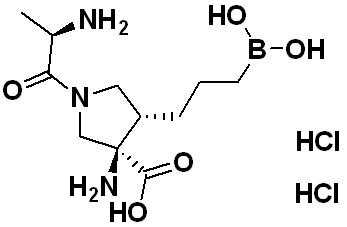Powder: -20°C for 3 years | In solvent: -80°C for 1 year


Numidargistat dihydrochloride (CB-1158) is a highly potent and orally active chemical compound that effectively inhibits arginase. It exhibits IC50 values of 86 nM and 296 nM for recombinant human arginase 1 and 2, respectively. Numidargistat dihydrochloride contributes to immuno-oncology, making it a valuable agent in the field [1].

| Pack Size | Availability | Price/USD | Quantity |
|---|---|---|---|
| 25 mg | 10-14 weeks | Inquiry | |
| 50 mg | 10-14 weeks | Inquiry | |
| 100 mg | 10-14 weeks | Inquiry |
| Description | Numidargistat dihydrochloride (CB-1158) is a highly potent and orally active chemical compound that effectively inhibits arginase. It exhibits IC50 values of 86 nM and 296 nM for recombinant human arginase 1 and 2, respectively. Numidargistat dihydrochloride contributes to immuno-oncology, making it a valuable agent in the field [1]. |
| In vitro | Numidargistat dihydrochloride is a potent, orally-bioavailable arginase inhibitor, demonstrating significant efficacy against both recombinant human arginase 1 and 2, with IC 50 values of 86 nM and 296 nM, respectively. It also effectively inhibits arginase activity in human granulocyte, erythrocyte, and hepatocyte lysates, with IC 50 values of 178 nM, 116 nM, and 158 nM, respectively, and in cancer patient plasma (IC 50, 122 nM). Moreover, Numidargistat dihydrochloride potently inhibits arginase in HepG2 and K562 cell lines, as well as in primary human hepatocytes, with IC 50 values of 32, 139, and 210 μM, respectively. It does not affect NOS activity and is not cytotoxic to murine cancer cell lines, highlighting its specificity and potential therapeutic value [1]. |
| In vivo | Administered orally at a dosage of 100 mg/kg twice daily, Numidargistat dihydrochloride enhances the presence of tumor-infiltrating cytotoxic cells while reducing myeloid cell numbers in mice. Furthermore, when combined with PD-L1 blockade or LY 188011, it effectively suppresses tumor growth in mice implanted with CT26 cancer cells [1]. |
| Molecular Weight | 360.04 |
| Formula | C11H24BCl2N3O5 |
Powder: -20°C for 3 years | In solvent: -80°C for 1 year
You can also refer to dose conversion for different animals. More
bottom
Please see Inhibitor Handling Instructions for more frequently ask questions. Topics include: how to prepare stock solutions, how to store products, and cautions on cell-based assays & animal experiments, etc.
Numidargistat dihydrochloride inhibitor inhibit
